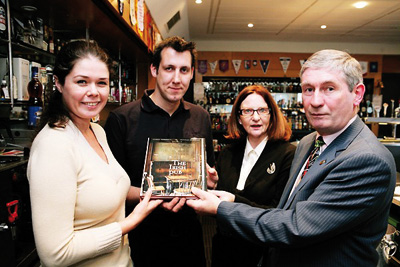WorldIrland
Beer TastingMan has been brewing beer for as long as he is farming. Agriculture developed in the fertile lands of the Eastern Mediterranean about 8,000 years ago when wild cereals were “tamed” and cultivated for the first time. Grain was eaten as porridge, ground to make bread and brewed as beer. Brewing and bread making developed in tandem and beer, sometimes called “liquid bread”, was an integral part of man’s diet, being both nutritious and thirst quenching.
Worldwide there is a great variety of beers from the lightest of styles in both colour and alcohol to the darkest in colour and highest in alcohol. Beer is a varied and exciting drinks sector.
To Begin Tasting
Start with clean glasses, preferably matched to the right type of beer. Begin with the lightest style in both colour and alcohol, and then progress to the darkest in colour and highest in alcohol. As you start tasting, pay close attention to the bouquet, taste and swallow.
Nose
The scent of beer has two main elements: aroma which is derived from ingredients like malt’s toastiness, and bouquet, which describes scents caused by fermentation like the banana-like smell of some wheat beers.
• Floral – Floral aromas frequently derive from hops, which impart a complex range of scents, and are especially common in pilsner.
• Fruity – Fruity bouquets stem from esters created in fermentation and are common in ales, stouts, and doppelbock, while fruity aromas, like the ones in citrusy ales, derive from hops.
• Grassy – Hops contribute the grassy aromas to beer that are typically characterised by a fresh, “green” scent or herbal quality.
• Toasty – Malt, especially if darkly roasted, creates this rounded, rich aroma, often found in brown ales, stouts and dark lagers.
• Yeasty – This complex, bready aroma may be accompanied by hints of fruitiness and is more predominant in ales than lagers.
Taste
Take a sip and roll the beer around in your mouth to make sure it hits all the taste buds. Now consider what flavours you perceive.
• Fruity – A light tartness best exemplified by the lemony, citrusy taste of wheat beer or the cidery notes of lambic (Belgian speciality) beers.
• Roasted/malty – Hops create a spicy edge that is common in heavily hopped beers like rich ales, bitters and porters.
• Sweet – While most beers are fermented until dry, barley wines do have residual sugars. Others may have sugars added.
Swallow
Unlike wine tasting, now it’s time to swallow. Assess the beer’s weight, the textural qualities made up of its alcohol level, carbonation, and density.
• Light bodied – Leaves a clean finish after swallowing.
• Medium bodied – Much heavier on the palate.
• Full bodied – Rounded, mouth-filling, sometimes creamy-textured, and often higher in alcohol.
Beer Styles and Taste
Lagers
• American Lager – Balance of hops and malt, crisp dry finish
• American Light Lager – Most popular style worldwide. Very refreshing and thirst quenching.
• Pilsner – Pronounced hops aroma with bitterness and refreshing finish.
• Amber Lager – Roasted, malty sweetness with well- balanced dry bitterness.
• Marzen/Oktoberfest – Mildly hopped with complex malt character.
• Bock – Rich, sweet caramels and warm, toasty flavours.
Ales
• Brown Ale – Malty flavour balanced with hints of caramel and chocolate.
• Amber Ale – Sweet caramel notes with citrusy aromas with smooth finish.
• Belgian Style Witbier – Unfiltered ale with orange, citrus and coriander aromas.
• American Wheat Ale – Very refreshing, slightly tart flavour with subtle citrus aroma.
• Blonde Ale – Smooth, malty sweetness and balanced bitterness.
• Indian Pale Ale – Substantial maltiness with pronounced hoppy aroma and flavour.
Stouts
• Irish Stout – The world’s most popular stout, malt and caramel flavours with a roasted bitterness.
• Sweet Stout – Hints of coffee with a creamy texture.
• Russian Imperial Stout – Strong malt flavours, hints of dark fruits.
• Porter – Roasted flavour complemented by nutty and toffee characteristics.
“When is a good time to order a beer”? Well with all the different styles available these days, beer has become so versatile that - whether pairing beer with food or just enjoying it on its own- a well-crafted brew can pretty much accompany any occasion.
 Photo left/right: Lisa O' Doherty, Irish Guild of Sommeliers,
Photo left/right: Lisa O' Doherty, Irish Guild of Sommeliers,
Michael Foggarty being presented with a book on Irish Pubs,
Mary O' Callaghan, President, Irish Guild of Sommeliers,
and Andrew O' Gorman.
Andrew O’ Gorman,
BA, HDE, MA, Honorary Life and Council Member Irish Guild of Sommeliers,
President Bartenders Association of Ireland,
Consultant, Author and Lecturer.
